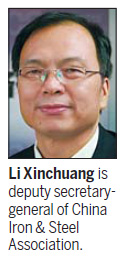Economy
Ore target to break foreign grip
Updated: 2011-07-25 09:14
By Zhang Qi (China Daily)
|
|
BEIJING - China, the world's largest steelmaker and iron ore consumer, has set a target of dramatically increasing ore imports from Chinese-invested resources in the steel industry's 12th Five-Year Plan (2011-2015), an industry official said.
Iron ore imports from Australia, Brazil and India accounted for 62.3 percent last year.
Li Xinchuang, deputy secretary-general of China Iron & Steel Association, told China Daily that the country will only be able to break the grip of the three major global miners - Vale SA, Rio Tinto, and BHP Billiton - if it gets half of its overseas ore requirements from Chinese-invested sources.
"China currently owns less than 10 percent of imported iron ore. We should seek 50 percent of ore from Chinese-invested overseas resources in the next five to 10 years," he said.
Li's remarks underscored the ambition of Chinese companies to secure steady supplies of ore globally.
Luo Bingsheng, deputy Party secretary of the association, said earlier that China has overseas mining rights capable of producing 150 million tons of ore annually, but most of the mines have yet to start production.
He accused the major global mining companies of taking advantage of supply falling short of demand to set prices at unreasonably high levels, squeezing profits from Chinese steel mills.
Last year, about 60 million tons of imported iron ore came from mines that had Chinese investment, the association said.
China has been enthusiastically seeking ore resources overseas in recent years to reduce its reliance on the big global miners.
The country's biggest steelmakers, including Baosteel, Wuhan Iron & Steel Group and Anshan Iron& Steel Group, have acquired or invested in overseas mines.
Wuhan Steel has set a goal of being self-sufficient in ore supplies by 2015.
Sichuan Hanlong made a recent bid for an iron ore project with identified reserves of 2.8 billion tons in West Africa.
Hanlong, a private conglomerate, last week offered A$1.2 billion ($1.3 billion) in cash to Australia-listed Sundance Resources Ltd to gain control of its ore project in West Africa.
The project is expected to start production in 2014, with annual production of 50 million tons, according to a company statement.
Liu Han, chairman of Hanlong, told China Daily that West Africa is emerging as a key region, as investment in Australia and Brazil faces a number of challenges.
"Australia and Brazil both have great resources, but they don't provide many opportunities for Chinese investors due to rising cost pressures and policy barriers. Furthermore, most of the resources and the attached infrastructure are controlled by the largest mine companies," he said.
Despite the fact that it will require a huge amount of investment to build railways and ports in Africa, China needs to diversify its ore supplies to break the monopoly of the global Big Three, Zhang Lin, an analyst with Beijing-based Lange Steel Research Information Center, said.
China imported 334 million tons of iron ore in the first six months of this year, up 8 percent over the year. The imports cost $53.78 billion, up 54 percent over the year.
According to data from the association, the average price of steel products rose 14.8 percent from January to May compared with a year ago, while the price for the raw material - imported ore - surged 47.8 percent over the same period.
The average profit ratio of the domestic steel industry from January to May was just 2.91 percent, far behind the national industrial average rate of 6 percent.
The market rate for Australian ore was steady at $179-$181 a ton with freight on Friday, Chinese consultancy Umetal said, up $10 a ton from the average price in May.
A recent report released by consultants Wood Mackenzie said ore prices will likely remain above $150 a ton until at least 2015.
This is due to bullish expectations among the big exporters, who are planning to boost production in the years ahead to capitalize on near-record prices as Chinese demand continues to soar.
Julian Kettle, head of metals research at Wood Mackenize, said a slowdown was likely after 2020.
By that stage China will have built 36 million units of cheaper housing and Chinese construction is currently boosting demand.
Li also said China's steel production could hit a new record of 700 million tons as construction starts on 10 million social units.

Specials

Turning up the heat
Traditional Chinese medicine using moxa, or mugwort herb, is once again becoming fashionable

Ciao, Yao
Yao Ming announced his retirement from basketball, staging an emotional end to a glorious career.

Financial sector short of talent
Lack of skilled professionals in Shanghai inhibiting the city's development as a financial hub
